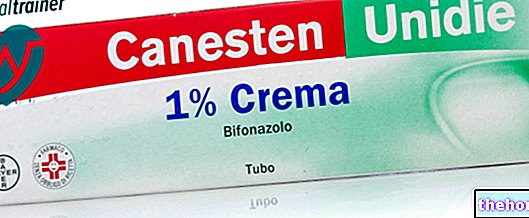Active ingredients: Bisacodyl
VERECOLENE C.M. 5 mg coated tablets
Why is Verecolene used? What is it for?
WHAT IS IT
VERECOLENE C.M. it is a contact laxative.
WHY IT IS USED
VERECOLENE C.M. it is used in the short-term treatment of occasional constipation.
Contraindications When Verecolene should not be used
Hypersensitivity to the active substance or to any of the excipients.
Patients with paralytic ileus, intestinal obstruction or stenosis, acute abdominal conditions including appendicitis, acute inflammatory bowel disease and severe abdominal pain associated with nausea and vomiting, which may be indicative of the conditions listed above.
Rectal bleeding of unknown origin, severe dehydration, gastroenteritis.
In children under 4 years of age. Pregnancy and breastfeeding (see "What to do during pregnancy and" breastfeeding ").
In case of hereditary conditions which may be incompatible with the intake of any of the excipients (see "It is important to know that").
Precautions for use What you need to know before taking Verecolene
In children between 4 and 12 years the medicine can only be used after consulting your doctor.
The treatment of chronic or recurrent constipation always requires the intervention of the physician for the diagnosis, the prescription of the drugs and the surveillance during the therapy.
Consult your doctor when the need for the laxative derives from a sudden change in previous bowel habits (frequency and characteristics of bowel movements) that has lasted for more than two weeks or when the use of the laxative fails to produce effects or when the patient is suffering from diabetes mellitus, hypertension or heart disease.
It is also advisable for elderly people or those in poor health to consult their doctor before using the medicine.
Interactions Which drugs or foods can modify the effect of Verecolene
Tell your doctor or pharmacist if you have recently taken any other medicines, even those without a prescription.
Laxatives can reduce the time spent in the intestine, and therefore the absorption, of other drugs administered simultaneously orally.
Therefore, avoid ingesting laxatives and other drugs at the same time: after taking a medicine, leave an interval of at least 2 hours before taking the laxative.
Milk and its derivatives, antacids or proton pump inhibitors can modify the effect of the medicine by reducing the resistance of the tablet coating and causing dyspepsia and gastric irritation, therefore they should not be taken together with VERECOLENE C.M. tablets.
Concomitant use of diuretics or corticosteroids may increase the risk of electrolyte imbalance if bisacodyl is taken in excessive quantities.
Electrolyte imbalance can lead to increased sensitivity to cardiac glycosides.
Warnings It is important to know that:
Like all laxatives, bisacodyl should not be used for more than five consecutive days without the cause of constipation being investigated.
In case of diabetes mellitus, hypertension or heart disease use only after consulting your doctor.
The abuse of laxatives (frequent or prolonged use or with excessive doses) can cause persistent diarrhea with consequent loss of water, mineral salts (especially potassium) and other essential nutritional factors.
In severe cases, the onset of dehydration or hypokalaemia (decrease in potassium in the blood) is possible, which can cause cardiac or neuromuscular dysfunctions, especially in the case of simultaneous treatment with cardiac glycosides, diuretics or corticosteroids.
The abuse of laxatives, especially contact laxatives (stimulant laxatives), can cause addiction (and, therefore, the possible need to gradually increase the dosage), chronic constipation and loss of normal intestinal functions (intestinal atony).
There have been reports of dizziness or syncope (see "Undesirable Effects") in patients who have taken bisacodyl. The available data on these cases suggest that these events may be compatible with defecation syncope (attributable to the effort of defecation itself) or with a vasovagal response to abdominal pain that can be associated with constipation and not necessarily with the intake of bisacodyl.
There have also been isolated reports of abdominal pain and haemorrhagic diarrhea after taking bisacodyl (see "Undesirable Effects"). Some cases have been related to ischemia of the colonic mucosa.
Intestinal fluid loss can cause dehydration. Symptoms can be thirst and oliguria.
In patients, for whom dehydration can be dangerous (patients with renal insufficiency, elderly patients), treatment with VERECOLENE C.M. it should only be stopped and restarted under the supervision of your doctor (see "Undesirable effects").
Patients may experience hematochezia (blood in stool), which is usually mild and self-limiting (see "Undesirable Effects").
When it can be used only after consulting your doctor
In pediatric age in children over 4 years (see Precautions for use).
It is also advisable to consult your doctor in cases where these disorders have occurred in the past.
What to do during pregnancy and breastfeeding
Ask your doctor or pharmacist for advice before taking any medicine.
There are no adequate and well-controlled studies on the use of the medicine in pregnancy. Therefore, although no toxic effects have ever been reported during pregnancy, the medicine should only be used in case of need, under the direct supervision of the doctor, after evaluating the expected benefit to the mother in relation to the possible risk to the fetus.
Clinical data show that the active form of bisacodyl and its glucuronic derivatives do not pass into the breast milk of healthy women, however the medicine should only be used in case of need, under the direct supervision of the doctor, after evaluating the expected benefit for the mother. in relation to the possible risk to the infant.
Consult your doctor if you suspect pregnancy or wish to plan a maternity leave.
Fertility Information
No studies have been conducted to investigate the effects on human fertility.
Effects on ability to drive and use machines
No studies on the effects of bisacodyl on the ability to drive and use machines have been performed.
However, patients should be advised that due to the vaso-vagal response (resulting from, eg, abdominal spasm) (see "Important to know:" and "Undesirable effects"), dizziness and / or syncope may occur. If patients experience abdominal spasm they should avoid potentially hazardous activities such as driving or operating machinery.
Important information about some of the excipients
VERECOLENE C.M. contains sorbitol therefore patients with rare hereditary problems of fructose intolerance should not take this medicine.
VERECOLENE C.M. contains sucrose therefore patients with rare hereditary problems of fructose intolerance, glucose-galactose malabsorption, or sucrase-isomaltase deficiency should not take tablets of this medicine.
Health education notes
First of all it must be borne in mind that, in most cases, a balanced diet rich in water and fiber (bran, vegetables and fruit) can permanently solve the problem of constipation.
Many people think they suffer from constipation if they fail to evacuate every day.
This is a mistaken belief as this situation is completely normal for a large number of individuals.
Consider, instead, that constipation occurs when the bowel movements are reduced compared to one's personal habits and are associated with the emission of hard stools.
If episodes of constipation occur repeatedly, a doctor should be consulted.
Dose, Method and Time of Administration How to use Verecolene: Posology
How many
- Adults and adolescents over 12 years of age: 1 to 2 coated tablets per day.
- Children from 4 to 12 years: 1 coated tablet, only after consulting your doctor.
The correct dose is the minimum sufficient to produce easy evacuation of soft stools.
It is advisable to initially use the minimum doses provided. When necessary, the dose can then be increased, without ever exceeding the maximum indicated.
Warning: do not exceed the indicated doses without medical advice.
When and for how long
Take preferably after the evening meal, so that the laxative effect, which occurs after 10-12 hours, does not disturb sleep.
As with all laxatives, VERECOLENE C.M. it must be used as infrequently as possible and in any case for no more than five continuous days.
The use for longer periods of time requires a doctor's prescription after adequate evaluation of the individual case.
Consult your doctor if the disorder occurs repeatedly or if you have noticed any recent changes in its characteristics.
Like
The coated tablets should be swallowed whole. Swallow with an adequate amount of water (a large glass).
A diet rich in liquids promotes the effect of the medicine.
Overdose What to do if you have taken too much Verecolene
In case of accidental ingestion of an excessive dose of VERECOLENE C.M. notify your doctor immediately or go to the nearest hospital.
Symptoms
Excessive doses can cause abdominal cramps, watery stools (diarrhea); clinically significant losses of fluids, potassium and other electrolytes.
Laxatives, taken in chronic overdose, can cause chronic diarrhea, abdominal pain, hypokalaemia, secondary aldosteronism and kidney stones. In association with chronic laxative abuse, renal tubular damage, metabolic alkalosis and muscle weakness secondary to hypokalaemia have been described.
See also the information in the "It's important to know" section about laxative abuse.
Treatment
After ingestion of VERECOLENE C.M., its absorption can be minimized or prevented by inducing vomiting. Fluid replenishment and correction of electrolyte imbalance (especially hypokalaemia) may be necessary. This is particularly important in elderly and young patients. Administration of spasmolytics may be helpful.
If you have any questions about the use of VERECOLENE C.M., ask your doctor or pharmacist.
Side Effects What are the side effects of Verecolene
Like all medicines, VERECOLENE C.M. it can cause side effects, although not everybody gets them.
The frequency convention used for the classification of undesirable effects is as follows: very common (≥1 / 10), common (≥1 / 100,
Disorders of the immune system
- Rare: anaphylactic reactions, angioedema, hypersensitivity.
Metabolism and nutrition disorders
- Rare: dehydration.
Nervous system disorders
- Uncommon: dizziness (see "It is important to know that").
- Rare: syncope (see "It is important to know that")
Gastrointestinal disorders
- Uncommon: haematochezia (blood in stool), vomiting, abdominal discomfort, anorectal discomfort (see "It is important to know that")
- Common: abdominal pain, abdominal cramps, nausea, diarrhea.
- Rare: colitis.
Compliance with the instructions contained in the package leaflet reduces the risk of undesirable effects.
These side effects are usually transient. However, when they occur, it is advisable to consult your doctor or pharmacist.
If any of the side effects gets serious, or if you notice any side effects not listed in this leaflet, please inform your doctor or pharmacist. Request and fill in the undesirable effects report form available at the pharmacy.
Expiry and Retention
Expiry: see the expiry date indicated on the package.
Warning: do not use the medicine after the expiry date indicated on the package.
The expiry date refers to the product in intact packaging, correctly stored.
Store at a temperature not exceeding 30 ° C.
Medicines should not be disposed of via wastewater or household waste. Ask your pharmacist how to dispose of medicines you no longer use. This will help protect the environment.
Keep this medicine out of the reach and sight of children.
It is important to always have the information about the medicine available, so keep both the box and the package leaflet.
Deadline "> Other information
COMPOSITION
One coated tablet contains: 5 mg bisacodyl.
Excipients: microcrystalline cellulose, pregelatinised maize starch, talc, glycerol behenate, povidone, sorbitol, shellac, methacrylic acid copolymer, ethyl phthalate, triethyl citrate, titanium dioxide, hypromellose, macrogol stearate 400, macrogol 6000, sucrose.
HOW IT LOOKS
VERECOLENE C.M. it comes in the form of coated tablets.
The contents of the pack are 20 coated tablets.
Source Package Leaflet: AIFA (Italian Medicines Agency). Content published in January 2016. The information present may not be up-to-date.
To have access to the most up-to-date version, it is advisable to access the AIFA (Italian Medicines Agency) website. Disclaimer and useful information.
01.0 NAME OF THE MEDICINAL PRODUCT -
VERECOLENE C.M. 5 MG COATED TABLETS
02.0 QUALITATIVE AND QUANTITATIVE COMPOSITION -
Each coated tablet contains:
Active ingredient: Bisacodyl 5 mg
For the full list of excipients see 6.1
03.0 PHARMACEUTICAL FORM -
Coated tablets
04.0 CLINICAL INFORMATION -
04.1 Therapeutic indications -
Short-term treatment of occasional constipation.
04.2 Posology and method of administration -
Adults and adolescents over 12 years of age:
1 to 2 coated tablets per day.
Children aged 4 to 12:
1 coated tablet per day, only after consulting your doctor.
The correct dose is the minimum sufficient to produce easy evacuation of soft stools. It is advisable to initially use the minimum doses provided. When necessary, the dose can then be increased, but without ever exceeding the maximum indicated.
Take preferably after the evening meal, so that the effect of the laxative, which occurs after 10-12 hours, does not disturb sleep.
As with all laxatives, VERECOLENE C.M. it must be used as infrequently as possible and in any case for no more than five continuous days. The use for longer periods of time requires a doctor's prescription after adequate evaluation of the individual case.
The tablets should be swallowed whole. Swallow with an adequate amount of water (a large glass). A diet rich in liquids promotes the effect of the medicine.
04.3 Contraindications -
Hypersensitivity to the active substance or to any of the excipients.
Patients with paralytic ileus, intestinal obstruction or stenosis, acute abdominal conditions including appendicitis, acute inflammatory bowel disease and severe abdominal pain associated with nausea and vomiting, which may be indicative of the conditions listed above.
Rectal bleeding of unknown origin, severe dehydration, gastroenteritis.
Contraindicated in children under 4 years of age.
Contraindicated in pregnancy and lactation (see "Fertility, pregnancy and lactation").
The use of VERECOLENE C.M. is contraindicated in case of rare hereditary conditions which may be incompatible with the intake of one of the excipients (see section 4.4 "Special warnings and precautions for use").
04.4 Special warnings and appropriate precautions for use -
Like all laxatives, bisacodyl should not be used for more than five consecutive days without the cause of constipation being investigated.
In case of diabetes mellitus, hypertension or heart disease use only after consulting your doctor.
The abuse of laxatives (frequent or prolonged use or with excessive doses) can cause persistent diarrhea with consequent loss of water, mineral salts (especially potassium) and other essential nutritional factors.
In severe cases, the onset of dehydration or hypokalemia is possible, which can cause cardiac or neuromuscular dysfunction, especially in the case of simultaneous treatment with cardiac glycosides, diuretics or corticosteroids.
The abuse of laxatives, especially contact laxatives (stimulant laxatives), can cause addiction (and, therefore, the possible need to gradually increase the dosage), chronic constipation and loss of normal intestinal functions (intestinal atony).
Intestinal fluid loss can cause dehydration. Symptoms can be thirst and oliguria. In patients, for whom dehydration can be dangerous (patients with renal insufficiency, elderly patients), treatment with VERECOLENE C.M. it should only be stopped and restarted under the supervision of your doctor (see "Undesirable effects").
There have been reports of dizziness or syncope (see "Undesirable Effects") in patients who have taken bisacodyl. The available data on these cases suggest that these events may be compatible with defecation syncope (attributable to the effort of defecation itself) or with a vaso-vagal response to abdominal pain that can be associated with constipation and not necessarily with the intake of bisacodyl. .
There have also been isolated reports of abdominal pain and haemorrhagic diarrhea after taking bisacodyl (see "Undesirable Effects"). Some cases have been related to ischemia of the colonic mucosa.
Patients may experience hematochezia (blood in stool), which is usually mild and self-limiting (see "Undesirable Effects").
In children between 4 and 12 years the medicine can only be used after consulting your doctor.
The treatment of chronic or recurrent constipation always requires the intervention of the physician for the diagnosis, the prescription of the drugs and the surveillance during the therapy.
Consult your doctor when the need for the laxative derives from a sudden change in previous bowel habits (frequency and characteristics of bowel movements) that has lasted for more than two weeks or when the use of the laxative fails to produce effects or when the patient is suffering from diabetes mellitus, hypertension or heart disease.
It is also advisable for elderly people or those in poor health to consult their doctor before using the medicine.
Important information about some of the ingredients:
VERECOLENE C.M. contains sorbitol therefore patients with rare hereditary problems of fructose intolerance should not take this medicine.
VERECOLENE C.M. contains sucrose therefore patients with rare hereditary problems of fructose intolerance, glucose-galactose malabsorption, or sucrase-isomaltase deficiency should not take tablets of this medicine.
04.5 Interactions with other medicinal products and other forms of interaction -
Laxatives can reduce the time spent in the intestine, and therefore the absorption, of other drugs administered simultaneously orally.
Therefore, avoid ingesting laxatives and other drugs at the same time: after taking a medicine, leave an interval of at least 2 hours before taking the laxative.
Milk and its derivatives, antacids or proton pump inhibitors can modify the effect of the medicine by reducing the resistance of the tablet coating and causing dyspepsia and gastric irritation, therefore they should not be taken together with VERECOLENE C.M. tablets.
Concomitant use of diuretics or corticosteroids may increase the risk of electrolyte imbalance if bisacodyl is taken in excessive quantities.
Electrolyte imbalance can lead to increased sensitivity to cardiac glycosides.
04.6 Pregnancy and breastfeeding -
No studies have been conducted to investigate the effects on human fertility.
There are no adequate and well-controlled studies on the use of the medicine in pregnancy. Therefore, although no toxic effects have ever been reported during pregnancy, the medicine should only be used in case of need, under the direct supervision of the doctor, after evaluating the expected benefit to the mother in relation to the possible risk to the fetus.
A clinical study shows that neither the active form of bisacodyl (BHPM or bis- (p-hydroxyphenyl) -pyridyl-2-methane), nor its glucuronic derivatives are excreted in the breast milk of healthy women, however the medicine should only be used in case of need, under the direct supervision of the doctor, after evaluating the expected benefit for the mother in relation to the possible risk for the infant.
04.7 Effects on ability to drive and use machines -
No studies on the effects of bisacodyl on the ability to drive and use machines have been performed.
However, patients should be advised that due to the vaso-vagal response (resulting from, for example, abdominal spasm) (see "Special warnings and precautions for use" and "Undesirable effects"), dizziness and / or syncope If patients experience abdominal spasm they should avoid potentially hazardous activities such as driving or operating machinery.
04.8 Undesirable effects -
Adverse reactions identified during post-marketing use are listed below.
The frequency convention used for the classification of undesirable effects is as follows: very common (≥1 / 10), common (≥1 / 100,
Disorders of the immune system
Rare: anaphylactic reactions, angioedema, hypersensitivity.
Metabolism and nutrition disorders
Rare: dehydration.
Nervous system disorders
Uncommon: dizziness (see "Special warnings and special precautions for use").
Rare: syncope (see "Special warnings and special precautions for use").
Gastrointestinal disorders:
Uncommon: haematochezia (blood in faeces) vomiting, abdominal discomfort, anorectal discomfort (see "Special warnings and special precautions for use").
common: abdominal pain, abdominal cramps, nausea, diarrhea.
Rare: colitis.
04.9 Overdose -
Signs and symptoms:
Excessive doses can cause abdominal cramps, watery stools (diarrhea), clinically significant losses of fluids, potassium and other electrolytes.
Laxatives, taken in chronic overdose, can cause chronic diarrhea, abdominal pain, hypokalaemia, secondary aldosteronism and kidney stones. In association with chronic laxative abuse, renal tubular damage, metabolic alkalosis and muscle weakness secondary to hypokalaemia have been described.
See also the information in the paragraph "Special warnings and appropriate precautions for use" about the abuse of laxatives.
Treatment:
After ingestion of VERECOLENE C.M., its absorption can be minimized or prevented by inducing vomiting. Fluid replenishment and correction of electrolyte imbalance (especially hypokalaemia) may be necessary. This is particularly important in elderly and young patients. Administration of spasmolytics may be helpful.
05.0 PHARMACOLOGICAL PROPERTIES -
05.1 "Pharmacodynamic properties -
Pharmacotherapeutic group: contact laxatives
ATC code: A06AB02
Pharmacological activities and mechanism of action: bisacodyl, active principle of VERECOLENE C.M., derived from diphenylmethane belongs, by virtue of its mechanism of action, to contact laxatives. It increases the water content in the stool and the rate of intestinal transit.
These phenomena are linked both to a modification of the permeability of the intestinal mucosa and to a release of prostaglandins.
In the first case there is an increase of ions in the intestinal lumen which exert an osmotic effect; in the second case an increase in cAMP in the mucosa which causes the release of electrolytes in the lumen.
VERECOLENE C.M. It can be used in any case of acute or chronic constipation including those antepartum and elderly patients.
VERECOLENE C.M. can provide excellent intestinal cleansing in the pre and post surgical phases, in proctoscopy, sigmoidoscopy and in radiological examinations in place of enema.
VERECOLENE C.M. produces copious mollinia feces formed, such as to facilitate defecation in case of hemorrhoids.
05.2 "Pharmacokinetic properties -
After oral administration bisacodyl is rapidly converted by intestinal and bacterial enzymes to the active desacetylated metabolite. Absorption is approximately 5% of the administered dose and the product is excreted in the urine as a glucuronide. This metabolite is also excreted in the bile and can be hydrolyzed in the colon to form the active drug.
05.3 Preclinical safety data -
Acute toxicity studies in rats did not reveal toxic effects; the oral LD50 was> 3g / kg.
Epidemiological studies have shown that bisacodyl has never been implicated as a mutagen, nor is its chemical structure considered potentially mutagenic.
There is no evidence of bisacodyl-induced fetal harm, however the drug in pregnancy should only be used when needed, under direct medical supervision (see section 4.6 Pregnancy and lactation).
A study has shown that bisacodyl, at the maximum usable dose in the test (8000 mg / kg / day), showed neither genotoxicity nor induction of carcinogenesis.
06.0 PHARMACEUTICAL INFORMATION -
06.1 Excipients -
Microcrystalline cellulose, pregelatinised maize starch, talc, glycerol behenate, povidone, sorbitol, shellac, methacrylic acid copolymer, ethyl phthalate, triethyl citrate, titanium dioxide, hypromellose, macrogol stearate 400, macrogol 6000, sucrose.
06.2 Incompatibility "-
None known.
06.3 Period of validity "-
30 months
06.4 Special precautions for storage -
Store at a temperature not exceeding 30 ° C.
06.5 Nature of the immediate packaging and contents of the package -
Primary container:
Blister of 20 coated tablets consisting of the aluminum / P.V.C. Coupled with titanium dioxide
Secondary container:
Cardboard case
06.6 Instructions for use and handling -
None.
07.0 HOLDER OF THE "MARKETING AUTHORIZATION" -
GLAXOSMITHKLINE CONSUMER HEALTHCARE S.p.A. - Via Zambeletti s.n.c.
Baranzate (Milan)
08.0 MARKETING AUTHORIZATION NUMBER -
A.I.C .: 033708013
09.0 DATE OF FIRST AUTHORIZATION OR RENEWAL OF THE AUTHORIZATION -
Last renewal: November 2007
10.0 DATE OF REVISION OF THE TEXT -
May 2012




























